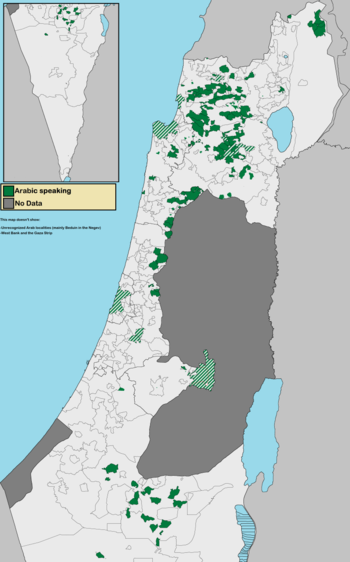Arab localities in Israel
Arab localities in Israel include all population centers with a 50% or higher Arab population in Israel. East Jerusalem and Golan Heights are not internationally recognized parts of Israel proper but have been included in this list.

The city of Acre has an Arab minority of 32%, while its Old City is 95% Arab. While Arabs constitute 11% of Haifa's total population, they make up 70% of Lower Haifa's residents.[1] Lod has an Arab population of 30%, while Ramla is 23% Arab. In 2015, 23% of the population of Nof HaGalil was Arab.[2]
Central and Haifa Districts
158,900 Arabs live in the Central District, which has a total population of 1,931,000.[3] 237,200 Arabs live in the Haifa District, which has a total population of 939,000.[3]
The majority of the Arab population in these areas live along or near the Green Line which separates Israel from the West Bank in an area known as the "Triangle", split into the "Northern Triangle" (or Wadi Ara) and the "Southern Triangle".
There is a substantial Druze population in the Carmel region and the Wadi Nisnas neighborhood of Haifa.
Southern Triangle
Estimated population figures for 2018 are listed below.[4]
- Jaljulia: 9,984
- Kafr Bara: 3,594
- Kafr Qasim: 23,241
- Qalansawe: 22,788
- Tayibe: 43,127
- Tira: 26,162
- Zemer:[lower-alpha 1] 6,940
Northern Triangle
- Ar'ara[lower-alpha 2] 24,904
- Baqa al-Gharbiyye 29,393
- al-Arian 191
- Basma[lower-alpha 3] 9,779
- Jatt 11,798
- Kafr Qara 18,675
- Ma'ale Iron[lower-alpha 4] 14,833
- Meiser 1,970
- Umm al-Fahm 55,182
- Umm al-Qutuf 1,093
Haifa and Carmel region
- Wadi Nisnas, Halisa, Kababir and Abbas (Haifa neighborhoods)†
- Daliyat al-Karmel
- Ein Hawd
- Fureidis
- Ibtin
- Isfiya†
- Jisr az-Zarqa
- Khawaled
† Significant presence of Christian population
Tel Aviv District
18,500 Arabs live in the Tel Aviv District, which has a total population of 1,318,300.[3] 16,000 of them live in Jaffa, where they make up around a third of the population.
Jerusalem District
310,700 Arabs live in the Jerusalem District, which has a total population of 987,400.[3] The Arab populations of the Jerusalem District are primarily concentrated in East Jerusalem, which is internationally not considered part of Israel, but there are four other towns that exist within the district's jurisdiction. Abu Ghosh is the largest of them.
West Jerusalem
- Abu Ghosh 7,543
- Beit Jimal
- Ein Naqquba 3,424
- Ein Rafa 1,243
East Jerusalem
East Jerusalem was annexed by Israel after its victory over Jordan during the Six-Day War in 1967. East Jerusalem was joined with West Jerusalem, along with several surrounding Palestinian towns and villages. Today, Arabs constitute 61% of the population of East Jerusalem and 38% of that of Jerusalem as a whole. The following are Arab neighborhoods of Jerusalem.
- Beit Hanina (al-Jadid or Eastern portion)†
- Beit Safafa
- Jabel Mukaber
- Old City (Armenian, Muslim & Christian Quarters)†
- Ras al-Amud
- Sheikh Jarrah
- Shuafat
- Silwan
- Sur Baher
- At-Tur
- Umm Tuba
- Wadi al-Joz
- al-Walaja
† Significant presence of Christian population
Southern District
216,200 Arabs live in the Southern District, which has a total population of 1,146,600.[3] The Arab population lives primarily in the northwestern Negev and is entirely composed of Bedouins. Several towns in the area are not formally recognized by the government and do not receive basic utilities from the state (see unrecognized Bedouin villages in Israel). The largest Arab locality in the Negev is Rahat.
|
|
|
Northern District
705,200 Arabs live in the Northern District, which has a total population of 1,320,800.[3] In 2008, Arabs made up 53% of the Northern District's population, making it Israel's only district with an Arab majority. 44% of the Arab population lives in this district.[5] Nazareth is the largest city, with a population of approximately 66,000.[5]
- Abu Sinan†
- Arab al-Aramshe
- Arab al-Subeih
- Arab al-Na'im
- Arraba†
- Basmat Tab'un
- Beit Jann
- Bi'ina†
- Bir al-Maksur
- Bu'eine Nujeidat[lower-alpha 5]
- Daburiyya
- Ed Dahi
- Deir al-Asad
- Deir Hanna†
- Dmeide
- Eilabun†
- Ein al-Asad
- Ein Mahil
- Fassuta†
- Hamaam
- Hamdon
- Hurfeish†
- Hussniyya
- I'billin†
- Iksal
- Ilut
- Jadeidi-Makr[lower-alpha 6]
- Jish†
- Julis
- Ka'abiyye-Tabbash-Hajajre[lower-alpha 7]
- Kabul
- Kafr Kanna†
- Kafr Manda
- Kafr Misr
- Kafr Yasif†
- Kamanneh[lower-alpha 8]
- Kaukab Abu al-Hija
- Kfar Kama[lower-alpha 9]
- Kisra-Sumei[lower-alpha 10]
- Maghar†
- Majd al-Krum
- Manshiya Zabda
- Mashhad
- Mazra'a†
- Mi'ilya†
- Muqeible
- Nahf
- Na'ura
- Nazareth†
- Nein†
- Rameh†
- Ras al-Ein
- Rehaniya[lower-alpha 9]
- Reineh†
- Rumana
- Rumat al-Heib
- Sajur
- Sakhnin†
- Sallama
- Sandala
- Sha'ab
- Shefa-'Amr†
- Sheikh Danun
- Shibli–Umm al-Ghanam[lower-alpha 11]
- Sulam
- Suweid Hamira
- Tarshiha†[lower-alpha 12]
- Tamra
- Tuba-Zangariyye[lower-alpha 13]
- Tur'an†
- Uzeir
- Yafa an-Naseriyye†
- Yanuh-Jat[lower-alpha 14]
- Yarka
- Zarzir
† Significant presence of Christian population
Golan Heights
The Golan Heights was captured during the Six-Day War in 1967 and de facto annexed by Israel in 1981. Israel governs the Golan Heights as a part of the Northern District. As a result of the war, many villages were abandoned. The Israeli Head of Surveying and Demolition Supervision for the Golan Heights proposed the demolition of 127 of the unpopulated villages, with about 90 abandoned villages demolished shortly after 15 May 1968.[6][7] The demolitions were carried out by contractors hired for the job.[7] Five Arab towns remain today. 23,900 Arabs live in the Golan Heights.[3] The area is home to an approximately equal number of non-Arab Israelis.
|
† Significant presence of Christian population See also
Notes
References
|

